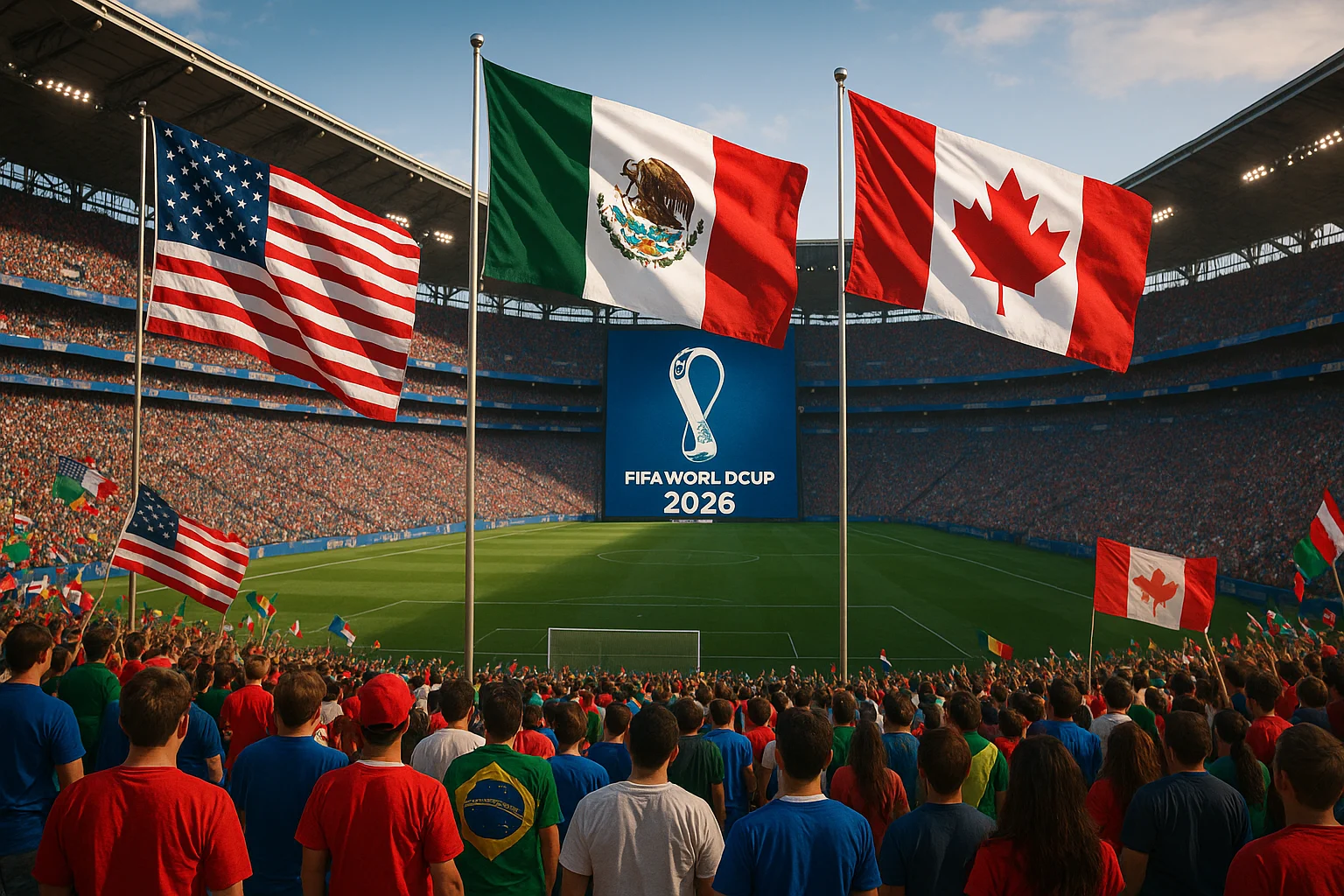In 2026, the world will witness something unprecedented. The globe’s most cherished sporting spectacle—the FIFA World Cup—will return, but this time, on a scale never before seen. Hosted across three countries—the United States, Canada, and Mexico—the 2026 FIFA World Cup promises to be the most ambitious, inclusive, and transformative tournament in the event’s rich history.
With 48 teams, 16 host cities, and millions of traveling fans expected, this World Cup is more than just a football tournament—it is a cultural phenomenon, a political symbol, and a blueprint for the future of sports.
Let’s explore the significance of this mega event, what makes it different, and why the world is already buzzing with anticipation.
1. The Most Inclusive World Cup Ever
Perhaps the most groundbreaking change in the 2026 edition is the expansion from 32 to 48 teams. This is a move designed not just to bring more matches, but to reflect the growing global nature of the game.
For decades, many competitive nations—especially from Africa, Asia, and the Middle East—have been sidelined due to limited slots. Now, countries like India, Uzbekistan, China, Vietnam, Nigeria, and others see a renewed hope of reaching the world’s biggest stage. This expansion is expected to inspire millions of new fans, bolster local investments in sport, and foster deeper international football development.
The format will change too: 48 teams will be split into 12 groups of four. The top two from each group and the eight best third-place teams will progress to a 32-team knockout phase, making the tournament even more unpredictable and thrilling.
2. A Tri-Nation Celebration Across a Continent
Never before has the World Cup spanned across three countries. This bold move by FIFA showcases the power of collaboration and the shared love for the beautiful game.
- United States brings massive stadiums, unrivaled infrastructure, and a booming football market that is growing rapidly thanks to MLS, the NWSL, and youth programs.
- Mexico, with its passionate football culture and historic ties to the World Cup (having hosted in 1970 and 1986), adds flavor, tradition, and fervor.
- Canada, a growing football nation after the success of its women’s team and a revitalized men’s squad, represents the new frontier of North American football.
Together, these countries will host matches in 16 cities, each a unique cultural and geographic hub—from the bustling streets of New York and Mexico City, to the tech-savvy skyline of Toronto, and the sunlit coastlines of Los Angeles and Miami.
This collaboration sends a powerful global message: unity, inclusion, and shared dreams can transcend borders.
3. Economic, Social, and Cultural Impact
The 2026 World Cup isn’t just a sports event. It’s a catalyst for change, with implications reaching far beyond the pitch.
Economic Boost
According to analysts, the World Cup is expected to generate over $11 billion USD in revenue. From hotels and transportation to food, merchandising, broadcasting rights, and sponsorships, every facet of the economy is set to benefit. Small businesses, especially in host cities, will see a boom.
Job Creation
Thousands of temporary and permanent jobs will be created across construction, security, logistics, tourism, and hospitality sectors. Moreover, volunteer programs are expected to involve youth from across the globe, making it a deeply participatory event.
Cultural Exchange
With fans traveling from over 100 countries, the World Cup becomes a cultural melting pot. It’s a chance to bridge cultural gaps, celebrate diversity, and experience global unity through a single passion: football.
4. Technological Evolution: The Smartest World Cup Yet
The 2026 World Cup will redefine the term “smart tournament” with an ecosystem built on cutting-edge technology.
- AI and real-time analytics will enhance coaching, player tracking, and even fan interactions.
- Augmented and virtual reality will be deployed at fan zones, allowing immersive experiences like virtually “standing” next to a player or walking through a stadium.
- Contactless stadiums with biometric entry, app-driven concessions, and real-time crowd management will offer seamless experiences.
- Green technologies such as solar-powered facilities, rainwater harvesting, carbon-neutral infrastructure, and sustainable transport will reduce the environmental footprint.
FIFA has also discussed potential use of blockchain for ticketing and merchandise authentication, preventing scams and counterfeiting.
5. The Future of Football Talent
With more nations participating, scouting and development will reach new heights. The world is already buzzing with anticipation for young stars set to dominate in 2026:
- Jude Bellingham (England) — poised to be one of the best midfielders in the world.
- Endrick (Brazil) — the teenage sensation already signed by Real Madrid.
- Gavi & Pedri (Spain) — controlling La Roja’s midfield with flair.
- Xavi Simons, Florian Wirtz, Giovanni Reyna, and Jonathan David—all part of a new generation ready to take center stage.
The expanded format will also introduce fans to undiscovered talents from nations like Mali, Japan, Ecuador, or Vietnam—proving once again that football is a global equalizer.
6. Beyond the Game: Emotions, National Pride, and Legacy
What separates the World Cup from other events is not just its scale—but its emotional impact.
- A single goal can define a lifetime.
- A nation’s hopes can rise and fall within 90 minutes.
- Heroes are made, legends are born, and stories are written in the ink of victory or heartbreak.
For host cities and nations, the legacy is long-lasting. Improved transportation, urban development, community sports programs, and global visibility remain even after the final whistle.
More importantly, the 2026 World Cup has the potential to inspire a generation—especially in North America, where young boys and girls will watch global icons live, dream bigger, and step onto local fields with new purpose.
7. Challenges Ahead: Can the Dream Match the Scale?
A mega event comes with mega responsibility. The 2026 World Cup will face several challenges:
- Logistics and Border Crossings: Coordinating travel, visa policies, and security across three countries with different legal systems and infrastructure will be complex.
- Environmental Responsibility: Balancing fan mobility and large-scale infrastructure with sustainability goals remains a concern.
- Inclusive Access: Ensuring that underserved communities—particularly indigenous populations, immigrants, and economically disadvantaged groups—also benefit from the event.
- Political Tensions: Immigration laws, geopolitical dynamics, and domestic issues could influence the experience for certain fan groups or national teams.
However, FIFA and local governments are already working on joint agreements, fan-friendly visa regimes, and community-focused planning to make this World Cup a model of coordination.
A Tournament That Will Change the Game
The 2026 FIFA World Cup is more than just another edition of a recurring tournament. It’s a statement. A symbol of growth, unity, technology, inclusiveness, and possibility.
With its expanded format, unprecedented geographic footprint, and bold ambition, it promises to redefine what a sporting event can be—not just in scale, but in soul.
As we count down the months, prepare your jerseys, learn a few new national anthems, and clear your calendars—because when the world plays together, magic happens.
FAQs: 2026 FIFA World Cup
Q1: When and where will the 2026 FIFA World Cup take place?
The tournament is scheduled for June–July 2026. It will be hosted jointly by United States, Canada, and Mexico across 16 cities.
Q2: How many teams will participate in 2026?
48 national teams will compete, making it the largest World Cup in history.
Q3: What is the new tournament format?
The 48 teams will be divided into 12 groups of 4 teams. The top two from each group and the 8 best third-place teams will advance to a 32-team knockout stage.
Q4: What are some of the major host cities?
Cities include New York/New Jersey, Los Angeles, Toronto, Vancouver, Mexico City, Miami, Dallas, San Francisco Bay Area, Philadelphia, Atlanta, Monterrey, and others.
Q5: How will fans get tickets?
FIFA will manage ticketing through its official platform. Fans can pre-register on fifa.com to receive updates about presale access.
Q6: What is FIFA doing about sustainability for this event?
Host cities are required to meet strict environmental sustainability guidelines, including renewable energy use, zero-waste programs, and public transit solutions.
Q7: How will security be managed across three countries?
Joint task forces involving inter-governmental security agreements are in place. A coordinated approach across borders will be used to manage fan safety, cyber threats, and stadium surveillance.
Q8: Will technology enhance the fan experience?
Absolutely. Expect AI-powered match stats, VR/AR fan zones, contactless entry, multilingual support apps, and blockchain-based ticketing.
Q9: What about the women’s game—will it benefit from the World Cup?
Yes. Increased infrastructure, media attention, and grassroots programs are expected to positively impact women’s football, especially in the US and Canada.
Q10: How can this World Cup help developing football nations?
The expanded format offers more qualification spots to developing football regions, giving exposure, experience, and investment to countries that previously had limited access.



